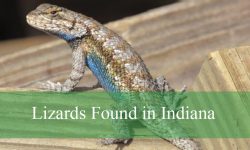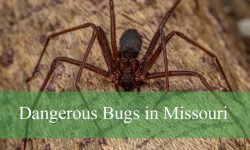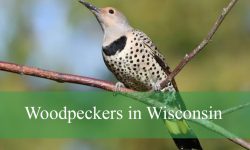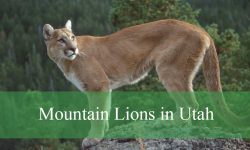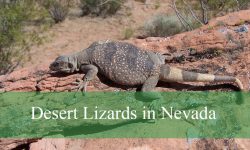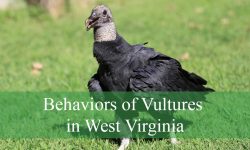Wisconsin’s landscapes come alive each year with a dazzling array of warblers, small songbirds famed for their bright plumage and lively songs. From the striking Yellow-rumped Warbler to the secretive Connecticut Warbler, these birds bring vibrant life to forests, wetlands, and woodlands throughout the state each year. Birdwatchers and nature lovers alike find joy in spotting and identifying these fascinating species.
This guide covers 37 species of warblers found in Wisconsin, featuring detailed descriptions and clear photos to assist with identification. Learn about their distinctive features, behaviors, and habitats to enhance your birdwatching experience in the state.
Common Warblers Found in Wisconsin
American Redstart (Setophaga ruticilla)
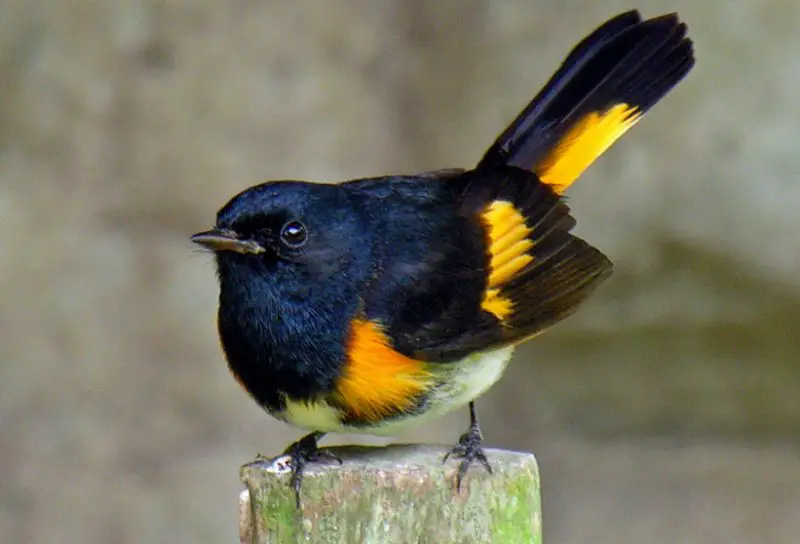
The American Redstart is a visually striking warbler, with males easily identified by their jet-black plumage highlighted with vivid orange patches on the wings, tail, and sides. Females and immature males look quite different, showing grayish-olive upperparts with yellow replacing the orange accents. Their constantly fanned tails flash brightly and help flush insects out of foliage.
This bird measures about 4.5 to 5.1 inches long, with a wingspan around 7 inches. It is known for its dynamic and acrobatic foraging style, often leaping between branches or sallying into the air to snatch flying insects. The Redstart’s song is a high-pitched series of short notes, and males are especially vocal during the breeding season to defend their territory.
In Wisconsin, American Redstarts are widespread summer breeders, particularly in moist deciduous and mixed forests. They are more common in the northern and central parts of the state but can be found nearly statewide. A fun fact about the species is that it’s sometimes called the “butterfly of the bird world” due to its flashy movements and vibrant wing displays.
American Yellow Warbler (Setophaga petechia)

The American Yellow Warbler is a cheerful-looking bird with uniformly bright yellow plumage accented by reddish streaks on the chest, particularly in males. Its round body, short tail, and prominent black eyes give it an endearing appearance. Females and young birds are plainer, typically yellow-green above and unmarked below, but still retain the species’ unmistakable golden hue.
This warbler measures around 5 inches in length and has a wingspan close to 7.5 inches. It is an active forager, often seen flitting through willows and low shrubs in search of caterpillars and other insects. The male sings a sweet, whistled song often translated as “sweet-sweet-sweet, I’m so sweet,” which helps establish its territory and attract a mate during breeding season.
In Wisconsin, the American Yellow Warbler is a widespread summer resident, especially common in shrubby wetlands, riparian woodlands, and overgrown fields. It breeds across much of the state and is among the earliest nesting warblers. A fascinating aspect of their behavior is their strategy for dealing with parasitic cowbird eggs—they often build a new nest layer over the top, burying the intruder’s egg and starting fresh.
Orange‑Crowned Warbler (Leiothlypis celata)

The Orange-crowned Warbler is a subtly colored species, often overlooked due to its drab olive-green appearance. As its name suggests, it has an orange patch on the crown, but this mark is usually hidden and only occasionally visible when the bird raises its crown feathers. It has faint streaks on its underparts and a thin, pale eye-line that helps distinguish it from other similar species.
This medium-small warbler measures around 4.75 to 5.5 inches in length with a wingspan of about 7 inches. It has a relatively plain song, consisting of a simple descending trill. Orange-crowned Warblers are methodical foragers, often creeping through low shrubs and understory vegetation in search of insects, spiders, and even nectar when available.
In Wisconsin, this species is mostly observed during spring and fall migrations, with occasional breeders found in the far northern areas. During migration, they use a variety of habitats, including brushy edges, thickets, and forest understories. A fun fact is that Orange-crowned Warblers are among the earliest warblers to pass through in spring and one of the few warblers that regularly visit suet feeders.
Nashville Warbler (Leiothlypis ruficapilla)
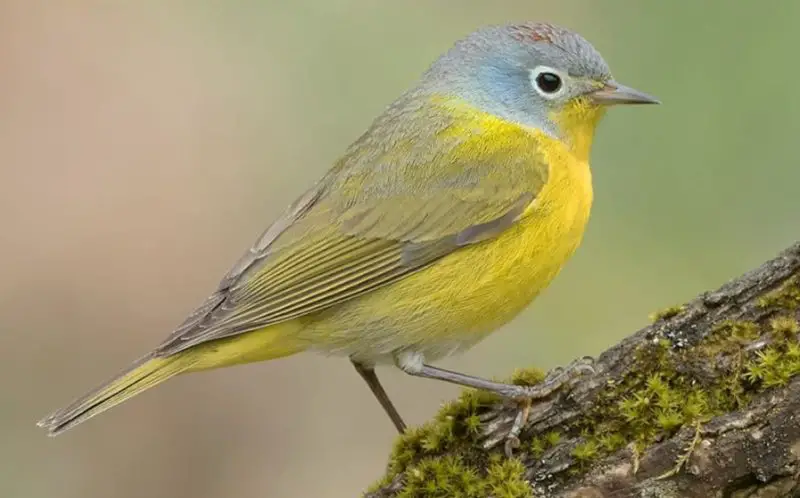
The Nashville Warbler is a petite, colorful bird known for its bright yellow underparts and contrasting olive-green back. It features a crisp white eye ring and a gray head, with males having a concealed rusty-orange crown patch that is rarely visible unless the feathers are fluffed. Females are similar but slightly duller in tone. This warbler’s neat, smooth plumage and bright eyes make it easy to recognize once spotted.
This species measures around 4.5 to 5 inches in length and has a wingspan of about 7.5 inches. Nashville Warblers are active and agile, typically foraging for insects in the mid to lower canopy and brushy undergrowth. Their song is a sweet, two-parted series of high-pitched notes often described as “see-bit, see-bit, see-bit, ti-ti-ti.” During migration, they can be found moving quickly through shrubs and young trees.
In Wisconsin, Nashville Warblers are common migrants and breed in northern parts of the state, particularly in mixed coniferous-deciduous forests and shrubby openings. They prefer regenerating clear-cuts and young aspen stands during nesting. A fun fact is that despite the name, this warbler does not breed near Nashville—its name was coined when the first specimen was collected there during migration.
Myrtle Warbler (Setophaga coronata coronata)
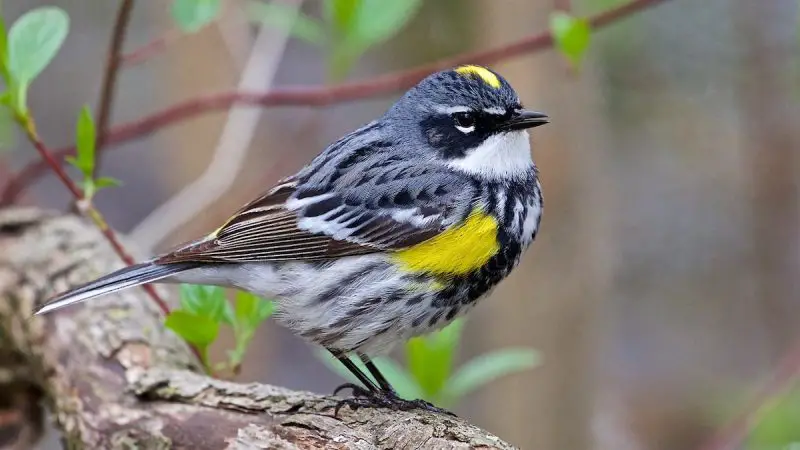
The Myrtle Warbler, a subspecies of the Yellow-rumped Warbler, is one of the most adaptable and widespread warblers found in North America. It sports a distinctive appearance with a grayish body, streaked sides, and bright yellow patches on the rump, crown, and sides. Males tend to be more vibrant in color, especially during the breeding season, while females and nonbreeding birds appear more subdued and brownish overall. The warbler also has a white throat and dark cheek patches which help distinguish it from other similar species.
This bird is medium-sized for a warbler, typically measuring about 5 to 5.5 inches in length with a wingspan of approximately 9 inches. It is known for its energetic behavior, often seen flitting through branches in search of insects. In colder months, it can also feed on berries—especially waxy ones like bayberry and juniper—making it one of the few warblers that can overwinter far north due to this dietary flexibility. Its high-pitched “chip” call and varied warbling song are common sounds in mixed forests.
In Wisconsin, Myrtle Warblers are a common sight during spring and fall migrations, and some even breed in the northern parts of the state, particularly in coniferous or mixed woodlands. They favor edges of forests, brushy fields, and wooded wetlands. A fun fact about this species is that it’s often among the first warblers to arrive in spring and the last to leave in fall, extending the warbler-watching season for bird enthusiasts in Wisconsin.
Wilson’s Warbler (Cardellina pusilla)
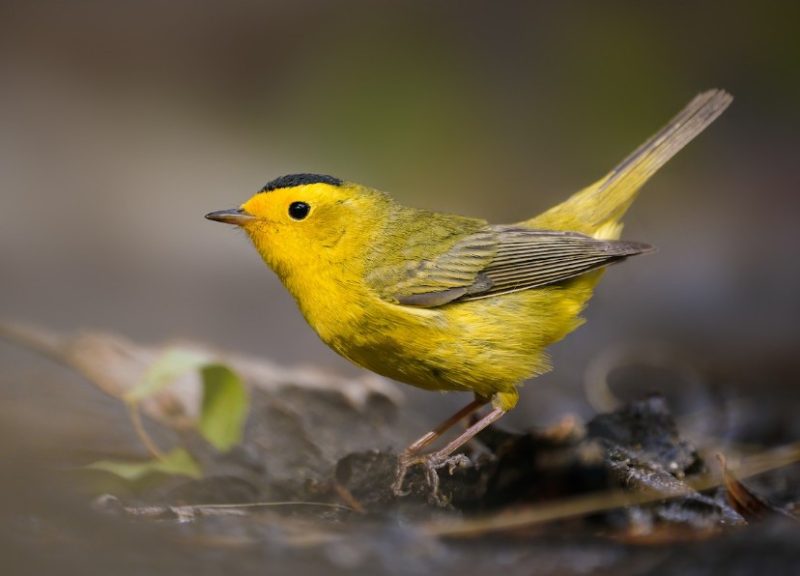
Wilson’s Warbler is a small, striking bird that is easy to recognize thanks to its bright yellow plumage and the distinctive black cap found on adult males. The rest of the body is a vibrant yellow with olive-green upperparts, making it stand out among the greenery. Females and immature birds also wear yellow but have a fainter or missing black cap, which can make identification more challenging during migration.
This warbler is one of the smallest of its kind, averaging around 4.3 inches in length with a wingspan of just under 6 inches. Wilson’s Warblers are very active and rarely stay in one place for long. They tend to forage low in shrubs or near the ground, constantly flicking their tails as they search for insects. Their soft, sweet trills are often heard before they are seen, especially in dense vegetation.
In Wisconsin, Wilson’s Warblers are seen primarily during migration, passing through in spring and fall as they journey between their breeding grounds in the boreal forests of Canada and their wintering sites in Central America. They favor moist, shrubby thickets and alder-lined streams during migration. A fun fact is that despite their small size, they make some of the longest migratory journeys among North American warblers.
Common Yellowthroat (Geothlypis trichas)
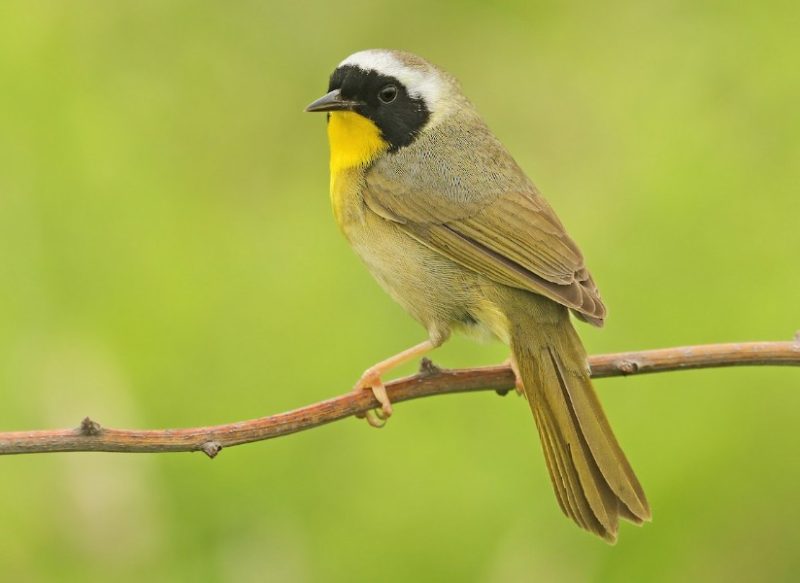
The Common Yellowthroat is a secretive, yet widespread warbler recognized by the male’s striking black facial mask bordered by white and bright yellow throat and chest. Females lack the mask but still display warm yellow underparts and olive-brown upperparts. Their rounded body, short tail, and sharp “chek” calls help birders detect them in dense cover.
This warbler is around 4.7 to 5.1 inches long with a wingspan of about 6 to 7 inches. Common Yellowthroats are ground-dwelling warblers often found in marshes, wet meadows, and shrubby thickets, where they forage for insects near the ground or in low vegetation. Males sing a loud “wichity-wichity-wichity” song, especially during the breeding season as they guard their territories.
In Wisconsin, the Common Yellowthroat is one of the most abundant breeding warblers, occupying wetlands, brushy fields, and even suburban gardens with thick undergrowth. It is commonly seen and heard across the state from spring through late summer. A fun fact is that this species has over a dozen recognized regional song dialects, making its tune slightly different depending on where you are in North America.
Black‑and‑White Warbler (Mniotilta varia)
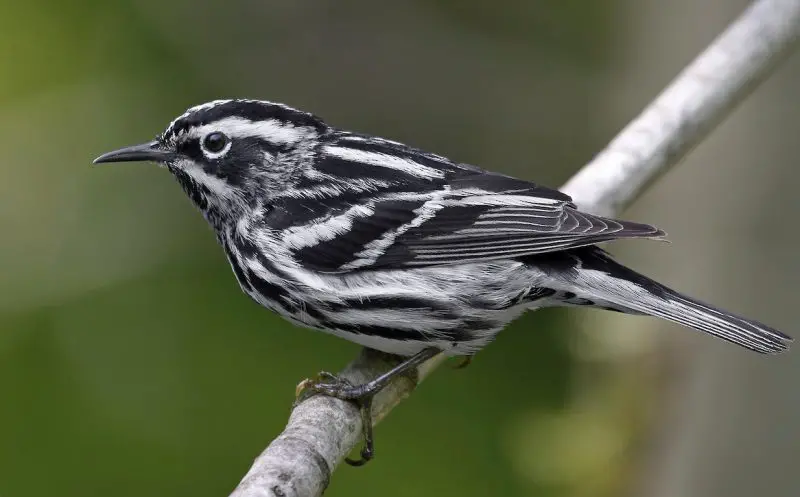
The Black-and-White Warbler is easy to identify thanks to its bold black-and-white striped plumage, resembling a miniature zebra. Males have more intense black markings, especially on the throat and face, while females are paler and more grayish. Its long, slightly curved bill and creeping behavior are also distinguishing features.
This bird measures about 4.3 to 5.1 inches in length with a wingspan of 7 to 8 inches. Unlike most warblers, the Black-and-White Warbler forages like a nuthatch or creeper, clinging to tree trunks and large branches as it searches for insects hidden in bark crevices. Its song is a high-pitched, squeaky “wee-see, wee-see, wee-see,” often repeated quickly.
In Wisconsin, this species is a regular migrant and summer breeder, especially in mature deciduous and mixed forests across the northern half of the state. It prefers woodland interiors but can also be found in forest edges during migration. A fun fact is that this warbler’s bark-gleaning foraging style allows it to exploit a niche different from most other warblers, reducing competition for food.
Northern Waterthrush (Parkesia noveboracensis)
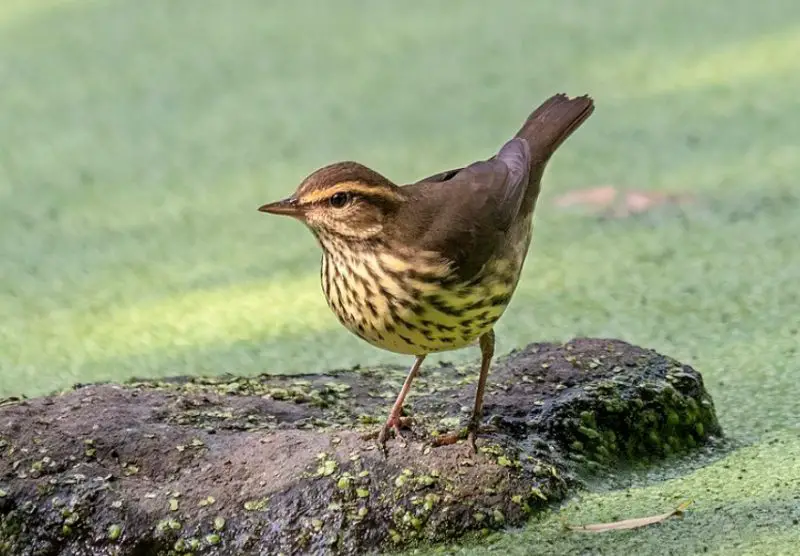
Despite its name, the Northern Waterthrush is a type of warbler, not a thrush, and can be identified by its brown upperparts, creamy underparts streaked with dark lines, and bold white eyebrow stripe. Its legs are typically pale pink, and its tail is often bobbing as it walks along stream banks. The bird’s overall appearance is somewhat thrush-like, with a heavier build than most warblers.
This species is about 5.75 to 6 inches long, with a wingspan of roughly 8.75 inches. It is known for its habit of walking rather than hopping, often found along muddy stream edges, bogs, and wooded swamps where it feeds on aquatic insects and invertebrates. Its song is a loud, emphatic series of slurred notes that echo through wet woods in spring.
In Wisconsin, Northern Waterthrushes breed primarily in the northern half of the state, favoring tamarack bogs, alder swamps, and slow-moving woodland streams. They are also fairly common during migration in wet, brushy areas statewide. A fun fact is that these birds will often return to the exact same swamp or stream each breeding season, showing strong site fidelity.
Ovenbird (Seiurus aurocapilla)
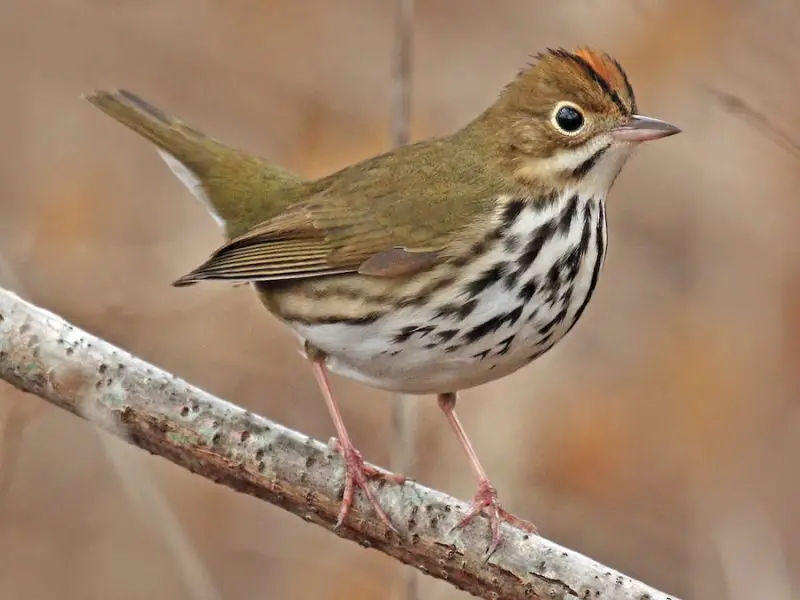
The Ovenbird is a large, robust warbler with olive-brown upperparts, white underparts boldly streaked with black, and a prominent orange crown bordered by black stripes. It has a round body and relatively long legs, giving it a thrush-like appearance. The bird gets its name from the covered, oven-shaped nest it builds on the ground in the forest understory.
This warbler measures around 5.5 to 6.3 inches in length and has a wingspan of 8.5 to 10.2 inches. Ovenbirds are ground foragers that walk through leaf litter in search of insects and other invertebrates. Their loud, ringing “teacher-teacher-teacher” song is a familiar sound in eastern forests during the summer months and is often repeated persistently from deep within the woods.
In Wisconsin, Ovenbirds are common summer residents throughout the state, particularly in mature deciduous and mixed forests. They nest on the forest floor, making them vulnerable to habitat disturbance and predation. A fun fact is that despite being a warbler, the Ovenbird’s singing voice is so strong and far-reaching that it can be heard over a hundred feet away in dense forest.
Golden-winged Warbler (Vermivora chrysoptera)
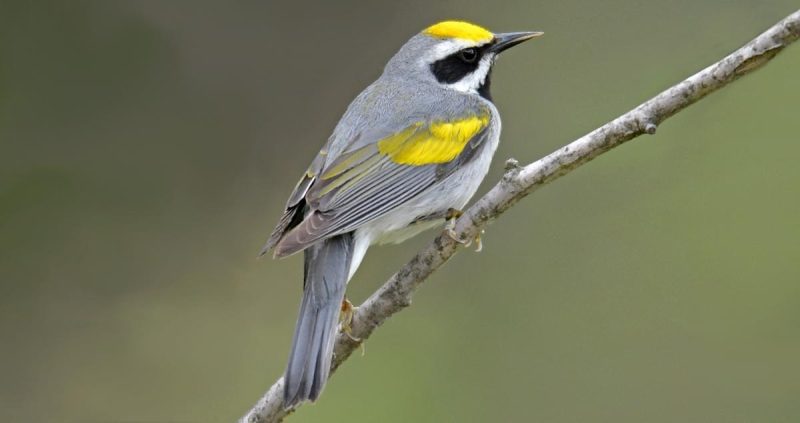
The Golden-winged Warbler is a striking small bird easily recognized by its gray body contrasted with bright yellow wing patches and a distinctive black throat and eye mask in males. Females are more subdued, lacking the black markings but still displaying the golden wing bars. Their sharp, crisp plumage and distinctive facial patterns make them stand out among other warblers.
This warbler is about 4.3 to 5 inches long with a wingspan near 7.5 inches. Golden-winged Warblers are active insect hunters, often seen flitting in shrubby habitats or young forests where they glean caterpillars, beetles, and other arthropods. Their vocalizations include buzzy songs and sharp chip notes used for communication during the breeding season.
In Wisconsin, Golden-winged Warblers are found mainly in early successional habitats such as shrubby fields, regenerating forests, and old burns, mostly in the northern and western parts of the state. They are considered a species of conservation concern due to habitat loss and hybridization with Blue-winged Warblers. A fun fact is that they sometimes hybridize with Blue-winged Warblers, producing “Brewster’s” and “Lawrence’s” warblers, which exhibit mixed plumage traits.
Blue-winged Warbler (Vermivora cyanoptera)
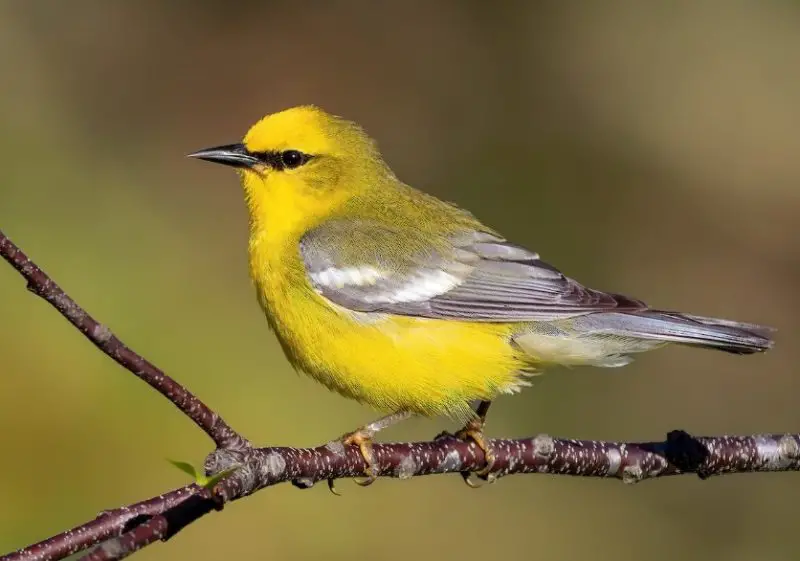
The Blue-winged Warbler is a small, bright yellow bird with blue-gray wings and tail. Males have a subtle black “mask” through the eyes, while females lack this marking and tend to be paler. Its overall bright coloration and contrasting blue wings make it relatively easy to identify in its preferred open habitats.
Measuring about 4.3 to 5 inches in length with a wingspan close to 7.5 inches, this warbler actively forages in low vegetation and shrubs, searching for insects and spiders. It has a buzzy, ascending song that sounds like a rapid “bee-bzz-z-z-z.” Blue-winged Warblers are known for their adaptability, often colonizing recently disturbed habitats like old fields and young forests.
In Wisconsin, Blue-winged Warblers are primarily found in southern and central parts of the state, favoring shrubby areas, open woodlands, and forest edges during the breeding season. They have been expanding their range northward, sometimes displacing Golden-winged Warblers. A fun fact is that their expanding range and hybridization with Golden-winged Warblers present an interesting case study in evolutionary biology and conservation.
Prothonotary Warbler (Protonotaria citrea)

The Prothonotary Warbler is a vibrant species known for its brilliant golden-yellow body and contrasting bluish-gray wings and tail. Males are especially bright during breeding season, while females are slightly duller but still vividly colored. Its large, dark eyes and stout bill add to its distinctive look, making it one of the most colorful warblers in eastern North America.
This species measures approximately 5 to 5.5 inches long, with a wingspan around 8.5 inches. Prothonotary Warblers are often found foraging slowly through dense tangles of vegetation, probing for insects and spiders near water bodies. Their clear, ringing song is a loud “sweet-sweet-sweet” phrase repeated frequently.
In Wisconsin, Prothonotary Warblers breed mainly in the southeastern part of the state, especially in flooded bottomland forests, swamps, and wooded wetlands. They nest in natural tree cavities or nest boxes near slow-moving water. A fun fact is that this warbler was named after 17th-century Catholic clerks known as “prothonotaries,” who wore bright yellow robes, reflecting the bird’s vibrant color.
Tennessee Warbler (Leiothlypis peregrina)
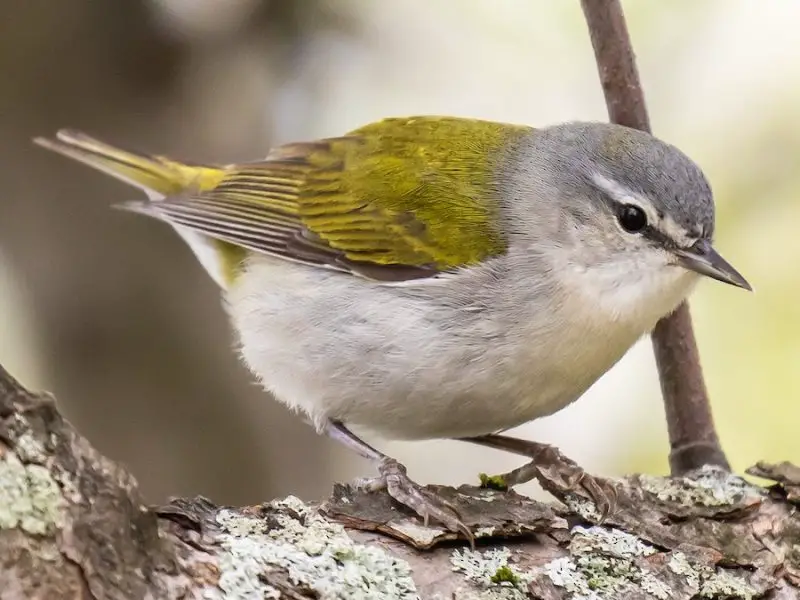
The Tennessee Warbler is a small, plain warbler with olive-green upperparts and pale yellow underparts. It has a subtle white eye ring and a relatively short tail. Although its plumage might appear simple, its rapid, bouncing flight and soft, sweet song help birders identify it during migration.
This warbler typically measures around 4.3 to 5 inches in length, with a wingspan of about 7.5 inches. Tennessee Warblers feed mostly on insects, especially caterpillars, and are often found in deciduous forests or shrubby habitats during migration. Their song is a fast, thin series of rising and falling notes, often described as a “sweet-sweet-sweet-tweet.”
In Wisconsin, Tennessee Warblers are primarily migrants passing through in spring and fall. Their breeding grounds lie mainly in the boreal forests of Canada, while they winter in Central America. A fun fact about Tennessee Warblers is their incredible long-distance migration, covering thousands of miles between breeding and wintering grounds each year.
Connecticut Warbler (Oporornis agilis)
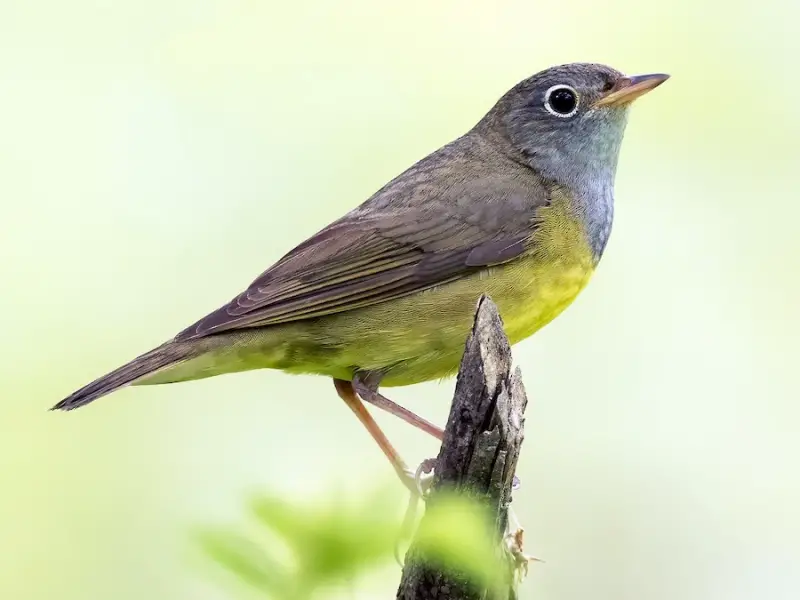
The Connecticut Warbler is a secretive and elusive warbler, often difficult to observe despite its fairly large size for a warbler. It has olive-gray upperparts, pale yellow underparts, and a distinctive white eye ring. Unlike many warblers, it lacks prominent wing bars or bright coloration, which makes its subtle plumage and shy behavior stand out.
This species measures about 5 to 6 inches in length with a wingspan around 8 inches. Connecticut Warblers prefer dense, damp thickets, bogs, and young forests, often skulking low in vegetation and feeding on insects and spiders. Their song is a clear, ringing series of musical phrases, which is often the best way to detect their presence.
In Wisconsin, Connecticut Warblers are rare breeders in the northern part of the state and are more commonly observed during migration. Their preference for dense, wet habitats makes them a challenge to spot. A fun fact is that this species was one of the last North American warblers to be properly documented by ornithologists, due to its secretive nature and remote breeding locations.
Mourning Warbler (Geothlypis philadelphia)
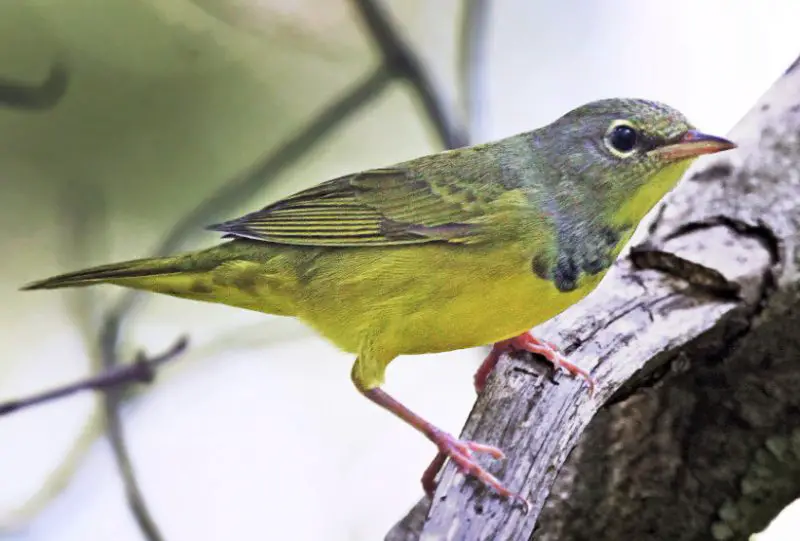
The Mourning Warbler is a medium-sized warbler recognized by its olive-green back, grayish head, and bright yellow underparts. Males feature a distinctive black patch on the throat and upper chest, which females lack, making females appear more uniformly yellow below. Their plain facial features and lack of bold markings can make identification tricky, but the contrasting dark throat patch in males helps distinguish them from similar species.
Measuring about 4.7 to 5.5 inches in length with a wingspan around 7.5 inches, Mourning Warblers are ground and understory foragers, often skulking through dense thickets and young forests. They feed primarily on insects and spiders, gleaning from leaf litter and low branches. Their song is a rapid, buzzy trill that is usually heard more often than the bird is seen.
In Wisconsin, Mourning Warblers breed mainly in dense young forests and brushy areas in the northern and central parts of the state during summer. They prefer habitats with thick understory growth, such as regenerating woodlands. A fun fact is that despite their name, Mourning Warblers have a cheerful and lively song that contrasts with the somber tone their name might suggest.
Kentucky Warbler (Geothlypis formosa)
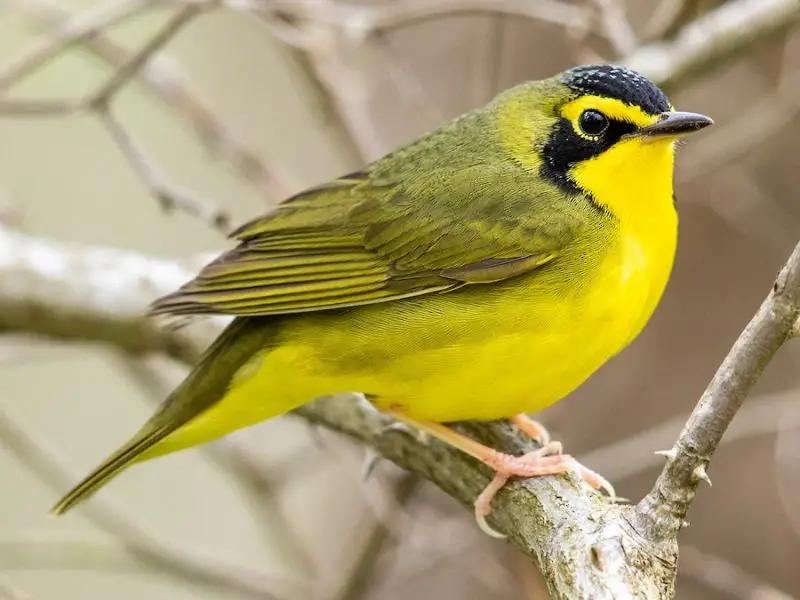
The Kentucky Warbler is a striking, ground-dwelling warbler with bright olive-green upperparts, a yellow underbelly, and a bold black mask running through the eyes and extending around the neck in males. Females have similar coloring but a less defined mask. This species is known for its relatively large size and robust build compared to other warblers.
Kentucky Warblers measure roughly 4.7 to 5.5 inches in length and have a wingspan of about 7.5 inches. They prefer to forage on the forest floor or in low shrubbery, picking insects and other arthropods from leaf litter. Their loud, ringing song is a series of clear, musical notes often described as a rapid “sweet-sweet-sweet-sweet, tea-cher, tea-cher.”
In Wisconsin, Kentucky Warblers are uncommon but can be found during migration and occasionally as summer breeders in the southern parts of the state. They favor mature deciduous forests with dense understory. A fun fact is that Kentucky Warblers are excellent runners and often scurry through thick brush to escape predators, rather than flying.
Hooded Warbler (Setophaga citrina)
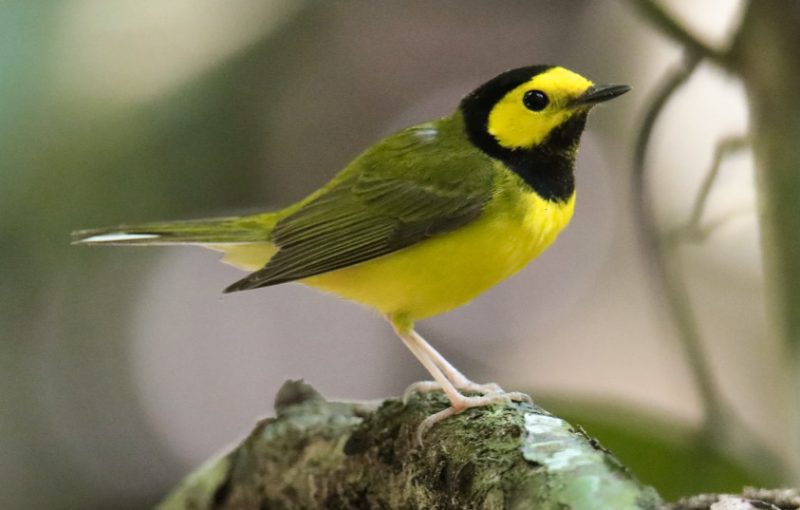
The Hooded Warbler is notable for its bright yellow face and underparts contrasted with a striking black hood and throat in males, which extends around the eyes and neck. Females lack the full black hood but still display a yellow face with some faint gray shading. Their bold coloration and distinct pattern make them one of the more recognizable warblers.
This warbler is about 4.7 to 5.1 inches long with a wingspan near 7.5 inches. Hooded Warblers actively forage in the lower and mid-levels of deciduous forests, searching for insects among leaves and branches. Their song is a loud, repetitive “ta-wit, ta-wit, ta-wit,” which males use to establish territory and attract mates during breeding.
In Wisconsin, Hooded Warblers are rare but regular migrants and occasional breeders, mostly in the southern and western parts of the state where mature forests and dense understory exist. A fun fact is that the Hooded Warbler is one of the few warbler species that sometimes nests on the ground beneath dense vegetation rather than in trees.
Cape May Warbler (Setophaga tigrina)
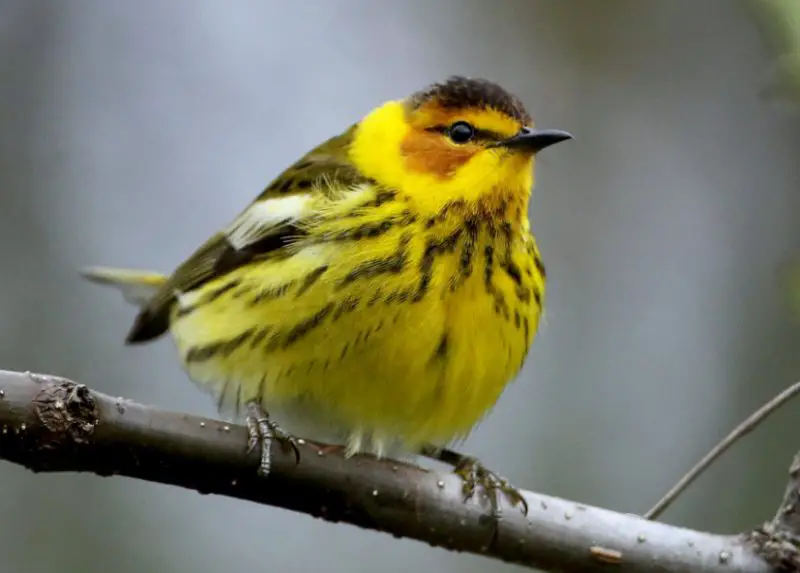
The Cape May Warbler is a strikingly patterned warbler with a distinctive streaked yellow body and chestnut-colored patches on the sides of the breast. Males show bold black streaks on a yellow face and a white eye ring, while females and immature birds are duller with less pronounced markings. Its slender build and pointed bill are suited for gleaning insects from conifers.
This species measures approximately 4.3 to 5 inches in length with a wingspan close to 7.5 inches. Cape May Warblers forage primarily in spruce and fir trees, extracting spruce budworms and other insects from needles and bark. Their song is a thin, high-pitched trill often described as “zee-zee-zee-zee-zee.”
In Wisconsin, Cape May Warblers breed mainly in the northern coniferous forests during summer and are seen migrating through the state in spring and fall. They prefer mature spruce-fir stands and are often associated with outbreaks of spruce budworms. A fun fact is that their specialized feeding habits tie their population cycles closely to the presence of spruce budworms, causing boom and bust population trends.
Cerulean Warbler (Setophaga cerulea)

The Cerulean Warbler is a medium-sized warbler known for its sky-blue upperparts and white underparts, making it one of the most beautiful and sought-after warblers in North America. Males exhibit vivid blue coloring on the head, back, and wings, with faint black streaking on the flanks. Females are duller with greenish-blue tones and more subtle markings.
Cerulean Warblers are about 4.3 to 5 inches long with a wingspan near 7.5 inches. They prefer to forage high in the canopy of mature deciduous forests, searching for caterpillars and other insects among leaves. Their song is a rapid, thin series of buzzy notes that can carry through the forest canopy.
In Wisconsin, Cerulean Warblers are considered rare but important breeders, mainly found in mature hardwood forests with tall trees in the southern and western parts of the state. They are sensitive to habitat fragmentation and forest degradation. A fun fact is that Cerulean Warblers often nest high in the treetops, making them challenging to observe despite their striking appearance.
Northern Parula (Setophaga americana)

The Northern Parula is a small, vibrant warbler known for its blue-gray upperparts and bright yellow throat and chest, accented by two white wing bars and a distinctive rusty band across the breast. Males are more vividly colored, while females appear slightly duller but still maintain the characteristic markings. Its tiny size and quick movements make it a lively presence in forest canopies.
Measuring around 4 to 4.5 inches in length with a wingspan of about 7.5 inches, Northern Parulas primarily forage in the upper layers of moist deciduous and mixed forests. They skillfully glean insects from moss and lichen that often cover tree branches. Their song is a buzzy trill that rises and falls, often heard during spring and summer.
In Wisconsin, Northern Parulas breed in moist, mature forests, especially in northern and central parts of the state, favoring areas with abundant moss and epiphytes. They are also common migrants throughout the state. A fun fact is that they sometimes build their nests within hanging moss, blending in perfectly with their environment.
Magnolia Warbler (Setophaga magnolia)
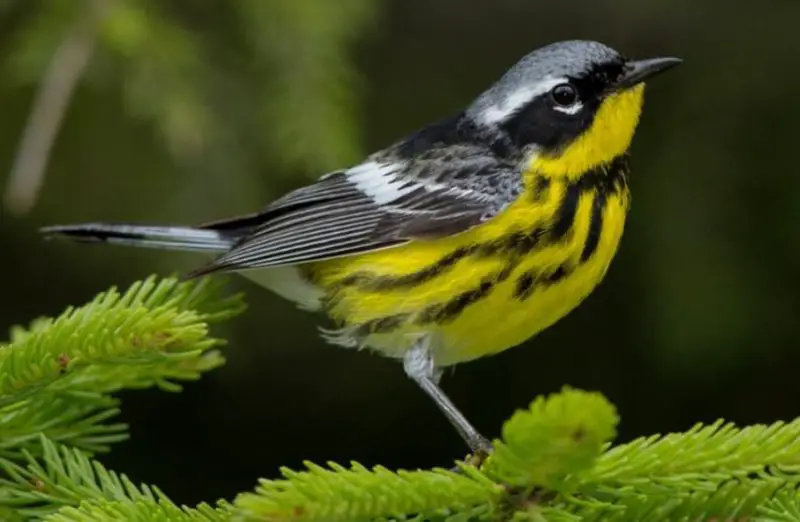
The Magnolia Warbler is a striking bird with bold black streaks on bright yellow underparts and a charcoal-gray back with a white wing patch. Males have a black mask and throat that contrast sharply with the yellow face, while females are paler with less distinct markings. Its vivid coloration and active behavior make it a favorite among warbler watchers.
This warbler measures about 4.5 to 5 inches long with a wingspan close to 8 inches. Magnolia Warblers forage actively in dense coniferous and mixed forests, flitting through branches to catch insects. Their song is a fast, buzzy trill, often repeated in a series of rising and falling notes.
In Wisconsin, Magnolia Warblers breed in the northern forests and are seen migrating through the state during spring and fall. They prefer spruce-fir habitats but can also be found in mixed hardwood forests. A fun fact is that during migration, Magnolia Warblers sometimes join mixed-species flocks, enhancing their chances of finding food and avoiding predators.
Bay-breasted Warbler (Setophaga castanea)

The Bay-breasted Warbler is easily identified by its rich chestnut-colored sides and crown, set against a contrasting black throat and white belly in males. Females and immature birds are duller but still display the characteristic chestnut wash. Its robust body and striking coloration set it apart from many other warblers.
This species measures roughly 4.7 to 5.5 inches in length with a wingspan of about 8 inches. Bay-breasted Warblers specialize in feeding on spruce budworms and other insects found in coniferous forests. Their song is a rapid, high-pitched series of buzzing notes that can carry through dense forest canopies.
In Wisconsin, Bay-breasted Warblers breed mainly in the northern coniferous forests, especially where spruce budworm outbreaks occur. They migrate through the state in spring and fall. A fun fact is that their population numbers fluctuate dramatically in response to the availability of spruce budworms, making them a key indicator species for forest health.
Blackburnian Warbler (Setophaga fusca)
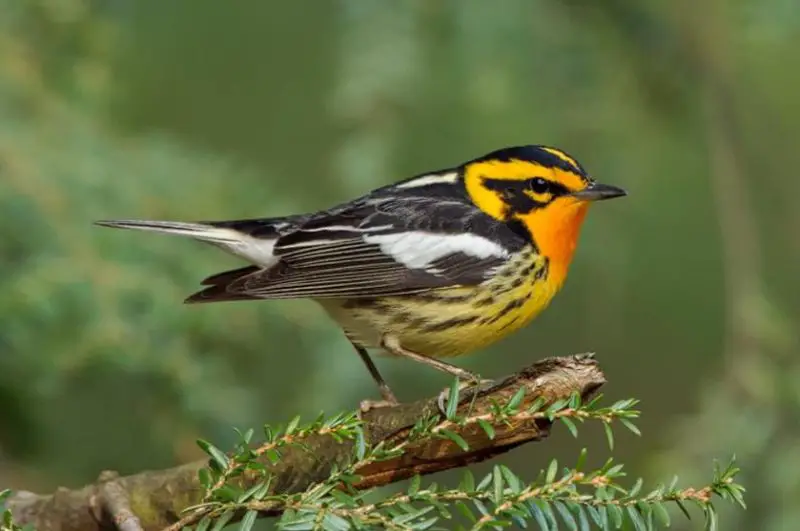
The Blackburnian Warbler is one of the most brilliantly colored warblers, with males displaying a fiery orange throat and face contrasted with black and white streaked upperparts. Females are less vibrant but still show a yellow-orange throat and olive tones on the back. Their sharp contrast and vivid colors make them a standout in any forest.
Measuring around 4.3 to 5 inches in length with a wingspan near 8 inches, Blackburnian Warblers favor the upper canopy of mature forests, where they hunt flying insects with quick, agile movements. Their song is a high-pitched, buzzy series of ascending notes that sound like “tee-tee-tee-tee.”
In Wisconsin, Blackburnian Warblers breed mainly in northern hardwood and mixed forests and are regular migrants throughout the state. They prefer tall, mature trees for nesting and foraging. A fun fact is that their brilliant coloration inspired their name, as early naturalists thought their plumage resembled the fiery colors of a burning coal.
Blackpoll Warbler (Setophaga striata)
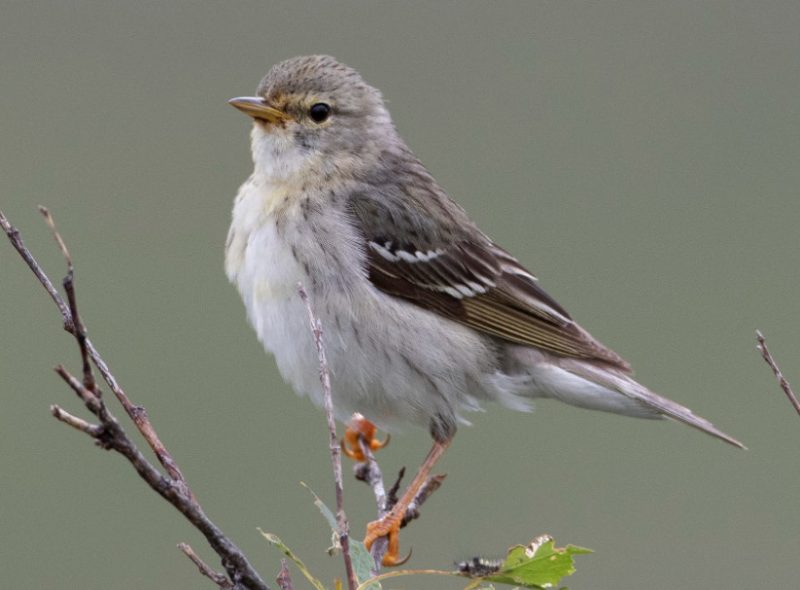
The Blackpoll Warbler is a small but robust warbler characterized by its bold black-and-white streaked back, white underparts with streaking on the sides, and a distinctive black cap in males. Females are similar but less sharply defined. Despite its plain coloration compared to some warblers, it is known for its remarkable endurance.
Measuring about 4.5 to 5 inches in length with a wingspan of roughly 8.5 inches, the Blackpoll Warbler is famous for its incredible long-distance migration, flying nonstop over the Atlantic Ocean to reach its South American wintering grounds. It feeds actively on insects and spiders in boreal forests during breeding season. Its song is a series of clear, ringing notes repeated rapidly.
In Wisconsin, Blackpoll Warblers breed in the northern boreal forests and are common migrants. Their breeding habitat includes spruce and fir stands with dense understory. A fun fact is that the Blackpoll Warbler’s marathon migration is one of the longest nonstop flights of any songbird, often covering more than 1,800 miles over open ocean.
Black-throated Blue Warbler (Setophaga caerulescens)
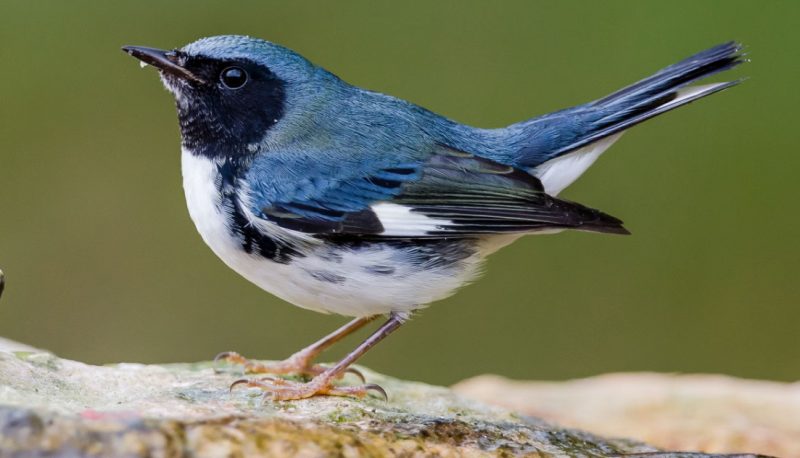
The Black-throated Blue Warbler is a strikingly beautiful warbler with males showcasing deep blue upperparts contrasted by a jet-black throat and face, along with white underparts. Females are olive-green above with yellowish underparts and lack the black throat, making them subtler but still elegant. This species’ bold coloration and white wing patch make it distinct among woodland warblers.
Measuring about 4.5 to 5 inches in length with a wingspan near 7.5 inches, Black-throated Blue Warblers prefer dense understory and mid-canopy layers of mature deciduous and mixed forests. They forage actively for insects, often flitting through foliage and capturing prey mid-air. Their song is a buzzy “zur-zur-zur-zur-zee,” frequently heard during spring and summer.
In Wisconsin, these warblers are mainly found in the northern forests during breeding season and are seen migrating throughout the state. They favor cool, moist woodlands with dense shrub layers. A fun fact is that male Black-throated Blue Warblers often return to the same breeding territories year after year, showing strong site fidelity.
Palm Warbler (Setophaga palmarum)

The Palm Warbler is easily recognized by its olive-brown upperparts, yellow underparts, and a distinctive rusty-colored cap that is often visible even at rest. Unlike many warblers, it often tails its tail downward and shows a distinctive bobbing motion while foraging. Both males and females have similar plumage, with slight variation in brightness.
This species is about 4.7 to 5.1 inches long with a wingspan around 7.5 inches. Palm Warblers forage on the ground and in low shrubs, frequently flicking their tails as they search for insects and berries. Their song is a simple, buzzy trill that is often repeated in short bursts.
In Wisconsin, Palm Warblers are common migrants and sometimes winter in the southern parts of the state. They use a wide range of habitats during migration, including open woodlands, marshes, and even suburban areas. A fun fact is that the Palm Warbler is one of the few warblers that often winters as far north as the northeastern United States and southern Canada, showing its adaptability to cooler climates.
Pine Warbler (Setophaga pinus)
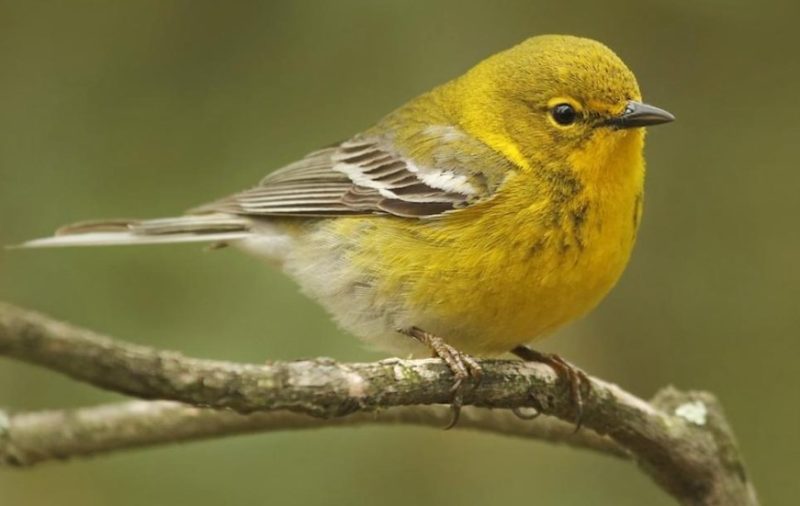
The Pine Warbler is a robust, somewhat chunky warbler with olive-green upperparts and bright yellow underparts. Males are more vibrant with yellow throats and chests, while females and juveniles tend to be duller. Unlike many other warblers, Pine Warblers often forage on pine needles and bark, making them closely tied to coniferous habitats.
This warbler measures about 5 to 5.5 inches in length with a wingspan around 8 inches. It forages slowly in pine trees, probing bark crevices and gleaning insects and seeds. Their song is a simple, musical trill often described as a repeated “sweet sweet sweet.”
In Wisconsin, Pine Warblers breed primarily in pine and mixed coniferous forests across the state, especially in the northern and central regions. They are among the few warblers that remain year-round in some parts of their range. A fun fact is that Pine Warblers often nest in pine trees, using open cups of grasses and bark in the branches.
Yellow-rumped Warbler (Setophaga coronata)
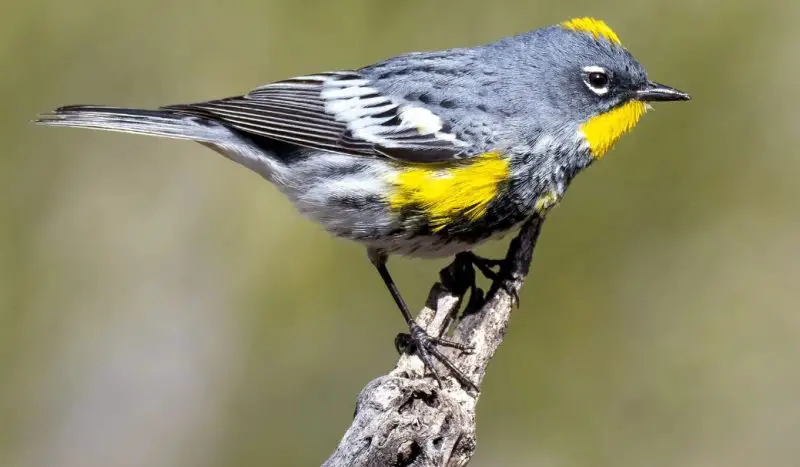
The Yellow-rumped Warbler is one of the most widespread and adaptable warblers in North America. It is characterized by its grayish body, streaked sides, and striking bright yellow patches on the rump, sides, and crown. Males in breeding plumage show bold black streaking and white patches on the wings, while females and nonbreeding birds are duller.
Measuring about 5 to 5.5 inches in length with a wingspan near 9 inches, Yellow-rumped Warblers forage actively in forests, shrublands, and even urban areas. They are highly versatile feeders, eating insects during the summer and berries during colder months, which allows them to overwinter farther north than many other warblers. Their song is a clear, buzzy trill often followed by a series of high notes.
In Wisconsin, Yellow-rumped Warblers are common migrants and breeders, especially abundant in coniferous and mixed forests throughout the state. A fun fact is that their ability to digest waxy berries like bayberry enables them to survive harsh northern winters better than most other warblers.
Yellow-throated Warbler (Setophaga dominica)
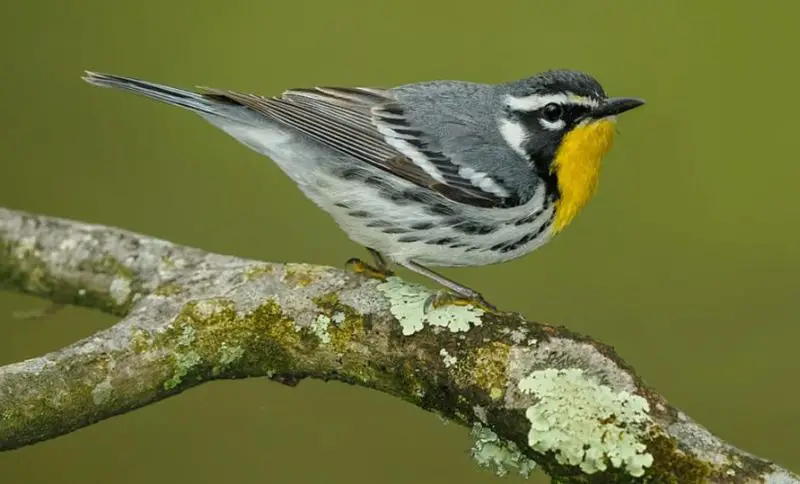
The Yellow-throated Warbler is a striking species with bold black-and-white striped upperparts and a bright yellow throat and chest. Males display strong black streaking on the face and sides, while females are slightly duller but still show the characteristic yellow throat. Their unique plumage and clear, high-pitched song make them distinctive.
This warbler measures approximately 5 to 5.5 inches in length with a wingspan near 8.5 inches. Yellow-throated Warblers favor mature pine and hardwood forests where they forage actively for insects by gleaning from bark and leaves. Their song is a loud, musical series of clear notes often described as “sweet sweet sweet, I’m so sweet.”
In Wisconsin, Yellow-throated Warblers are uncommon but regular migrants and occasional breeders, mostly in the southern parts of the state where mature forest habitats exist. A fun fact is that they often nest high in pine trees, building open cup nests on horizontal branches, sometimes quite high above the ground.
Prairie Warbler (Setophaga discolor)
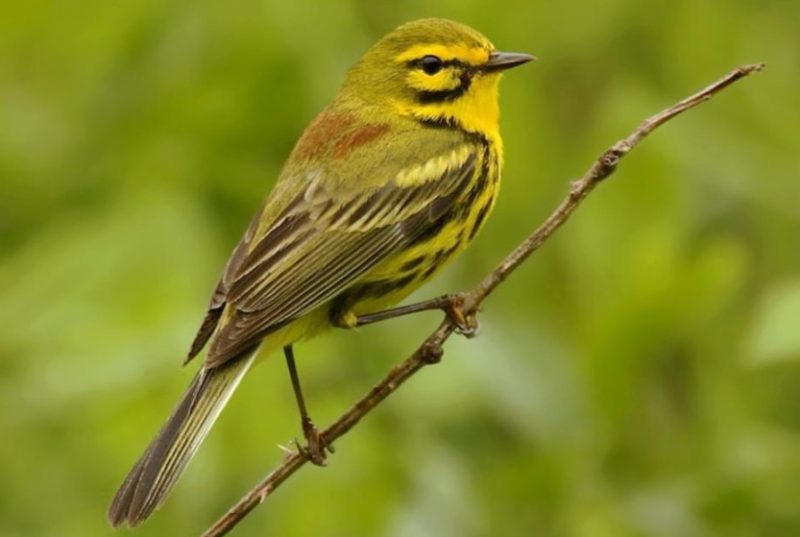
The Prairie Warbler is a small, energetic warbler known for its bright yellow underparts with bold black streaks on the sides and olive-green upperparts. Males display sharp black streaking on the face and crown, while females are paler with less intense markings. Its unique pattern and lively behavior make it a favorite among bird watchers.
Measuring about 4.3 to 5 inches in length with a wingspan around 7.5 inches, Prairie Warblers forage actively in open woodlands, shrubby fields, and young forests. They feed mainly on insects, often gleaning from leaves and twigs. Their distinctive song is a rising and falling series of buzzy notes, described as “zee-zee-zee, zzee-zzee-zzee.”
In Wisconsin, Prairie Warblers are rare and mostly seen during migration, with occasional breeding in the southernmost parts of the state. They prefer open habitats with scattered shrubs and trees. A fun fact is that Prairie Warblers often flick their tails while foraging, which may help flush out hidden insects.
Black-throated Gray Warbler (Setophaga nigrescens)
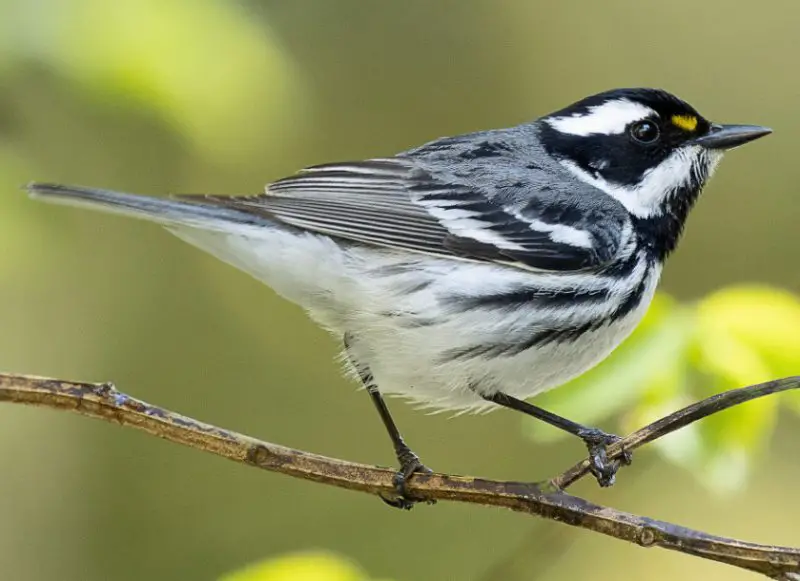
The Black-throated Gray Warbler is a striking bird with a clean gray back, white underparts, and bold black streaking on the throat and face, which extends to a distinct black bib in males. Its wings show white wing bars and patches that contrast sharply with the darker plumage. Females are similar but with less intense black markings.
This warbler is about 4.7 to 5 inches in length, with a wingspan near 7.5 inches. It prefers open coniferous and mixed forests, often foraging high in tree branches for insects and spiders. Its song is a rapid series of buzzy notes followed by a rising trill.
Though rare in Wisconsin, the Black-throated Gray Warbler is mostly a western species, occasionally recorded as a vagrant in the state. Its preferred habitat includes dry pine or oak woodlands. A fun fact is that this species often flares its white tail feathers while foraging, a behavior thought to startle insects.
Townsend’s Warbler (Setophaga townsendi)
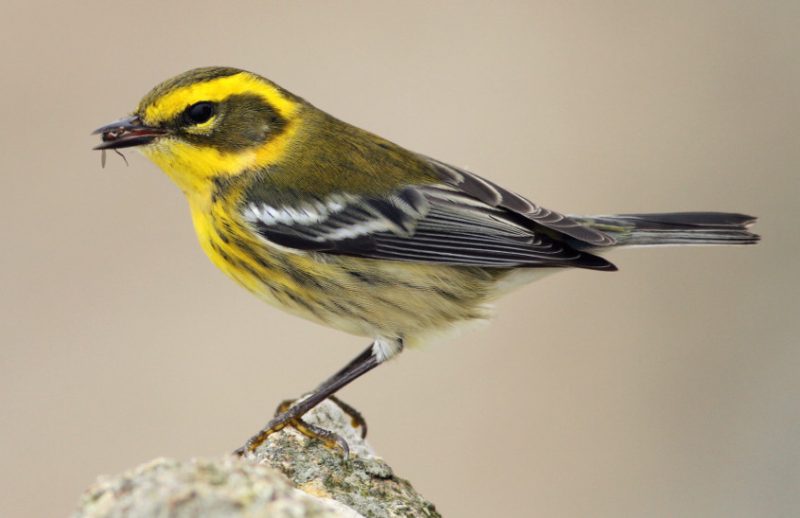
Townsend’s Warbler is a handsome bird with a yellow face and throat, accented by bold black streaking and a distinctive black “necklace” across the chest. Males display more vivid colors and markings than females, who tend to be paler. The combination of yellow, black, and olive gives it a striking appearance.
Measuring about 4.5 to 5 inches long with a wingspan around 7.5 inches, Townsend’s Warblers inhabit coniferous forests where they forage actively among branches for insects. Their song is a rapid, buzzy trill, often heard during spring and summer in their range.
In Wisconsin, Townsend’s Warbler is a rare visitor, mainly recorded during migration. Its primary breeding range lies in the Pacific Northwest and western Canada. A fun fact is that Townsend’s Warblers often associate with mixed-species flocks, joining forces with other warblers and small birds during migration and winter.
Hermit Warbler (Setophaga occidentalis)
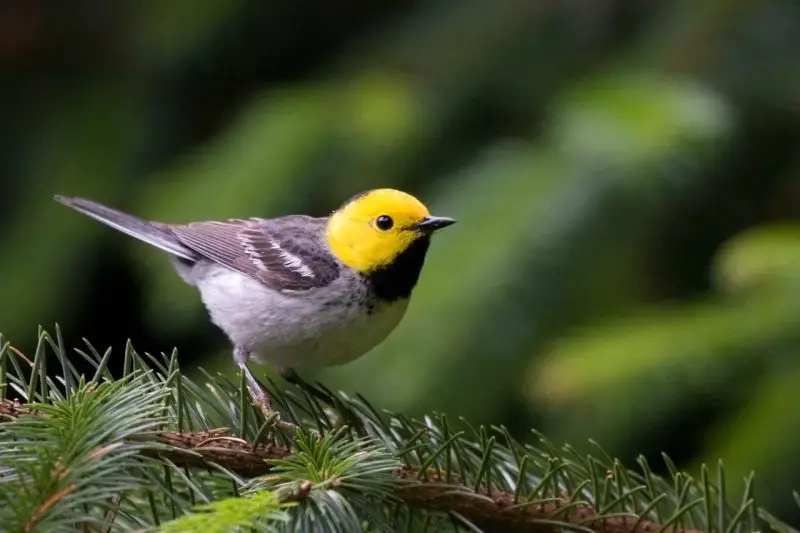
The Hermit Warbler is a striking species with a bright yellow face and underparts, contrasted by black streaking on the throat and a black “mask” extending from the bill through the eyes. Males have more extensive black on the head and throat, while females are less boldly marked but retain the yellow face.
This warbler measures approximately 4.5 to 5 inches in length with a wingspan close to 7.5 inches. Hermit Warblers favor mature coniferous forests, especially Douglas-fir and pine, where they glean insects from needles and bark. Their song is a distinctive buzzy trill followed by clear notes.
In Wisconsin, Hermit Warblers are rare vagrants, mostly found in the western United States and along the Pacific Coast during breeding season. Their occasional appearances in Wisconsin during migration excite birders. A fun fact is that Hermit Warblers sometimes hybridize with Townsend’s Warblers where their ranges overlap, creating interesting plumage variations.
Black-throated Green Warbler (Setophaga virens)

The Black-throated Green Warbler is a medium-sized warbler featuring olive-green upperparts and bright yellow face and throat, contrasted by a solid black throat patch that extends down the chest. Males display more prominent black markings, while females and juveniles are duller with less defined throats.
This species is about 4.7 to 5.5 inches long with a wingspan near 7.5 to 8 inches. It prefers mature deciduous and mixed forests where it forages actively in mid- to upper-level tree canopies for caterpillars and other insects. Their song is a sweet, buzzy trill often described as “zee-zee-zoo-zoo-zee.”
In Wisconsin, Black-throated Green Warblers are common breeders throughout much of the state, favoring mature woodlands with ample canopy cover. They are also frequent migrants. A fun fact is that this species can be surprisingly bold, sometimes visiting backyard feeders to snatch insects or suet.
Canada Warbler (Cardellina canadensis)

The Canada Warbler is a striking warbler with slate-gray upperparts, bright yellow underparts, and bold black “necklace” streaking across the chest. It has large, white eye rings that give it a wide-eyed appearance. Males and females look similar, though females tend to be slightly duller.
Measuring about 4.5 to 5 inches in length with a wingspan of approximately 7.5 inches, Canada Warblers prefer moist, dense forests and thickets, where they forage for insects near the ground and in low vegetation. Their song is a rapid, high-pitched series of clear whistles and trills.
In Wisconsin, Canada Warblers are found primarily during breeding season in the northern and central regions, favoring wet forests with dense understory. They are shy and secretive, making them a rewarding sight for birders. A fun fact is that Canada Warblers migrate long distances to South America, crossing the Gulf of Mexico in a nonstop flight.
FAQs About Warblers in Wisconsin
What species of warblers can be found in Wisconsin?
Wisconsin hosts over 30 species of warblers, including the Yellow-rumped Warbler, Nashville Warbler, Black-throated Green Warbler, and Ovenbird. Many are migratory visitors, while some breed in the state’s forests.
When is the best time to see warblers in Wisconsin?
The peak times to observe warblers in Wisconsin are during spring (May to early June) migration and fall migration (late August to September). Some species also breed locally in summer.
What habitats do warblers prefer in Wisconsin?
Warblers in Wisconsin occupy a range of habitats, including mature deciduous and mixed forests, young regenerating woods, wetlands, and shrubby fields depending on the species.
How can I identify warblers in Wisconsin?
Identification involves noting colors, patterns like wing bars or throat patches, songs, and preferred habitat. Warblers are often small and fast-moving, so binoculars and sound recognition help greatly.
Do warblers face threats in Wisconsin?
Yes, habitat loss, forest fragmentation, and climate change impact many warbler populations. Conservation efforts focus on protecting breeding and migratory habitats within the state.
Are there any rare or endangered warblers in Wisconsin?
The Golden-winged Warbler and Cerulean Warbler are considered species of concern in Wisconsin due to declining numbers and habitat pressures.
Where are good spots to birdwatch warblers in Wisconsin?
Popular locations include northern forests such as Chequamegon-Nicolet National Forest, Horicon Marsh, and state parks with mature woodlands and wetlands.
What do warblers eat in Wisconsin?
Warblers mainly feed on insects like caterpillars, beetles, and spiders during the breeding season. In migration and winter, some also consume berries and fruit.

